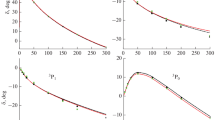Abstract
With the intermediate coupling theory — using the configuration space methods of the quantum theory of fields — we determine the state vector characterizing the real nucleon. We carry out our calculations for the case of interaction of the nucleon field described by the Dirac equation and the scalar, resp. pseudoscalar meson field. Pair creation is completely disregarded. Remaining within the frameworks of the configuration space method the recoil of the nucleon is considered. With the aid of the state vector we also calculate the mean value of some characteristic physical quantitites. The use of the configuration space method — particularly in connection with the computation of local physical quantities — makes possible to form a very clear picture about the real nucleon.
Резюме
Определяются векторы состояния, характеризующие реальные нуклоны, методом средней связи, используя методы конфигурационного пространства в квантовой теории полей. Расматривается взаимодействие между нуклонным полем, описиваемым уравнением Дирака, и скалярным или псевдоскалярным мезонним полем. Образование пар пренебрегается. В рамках конфигурационного метода учитывается и отдача нуклонов. С помощью вектора состояния определяются средние значения некоторых физических величин в состоянии реального нуклона. Из-за конфигурационного метода, — особенно при расчете локальных физических величин — получается очень наглядная картина реального нуклона.
Similar content being viewed by others
References
S. Tomonaga, Progr. Theor. Phys.,2, 6, 63, 1947.
K. Watson andF. Hart, Phys. Rev.,79, 918, 1950.
P. T. Matthews andA. Salam, Phys. Rev.,86, 715, 1952.
T. D. Lee andD. Pines, Phys. Rev.,92, 883, 1953.
Z. Maki, M. Sato andS. Tomonaga, Progr. Theor. Phys.,9, 607, 1953.
F. H. Harlow andB. A. Jacobson, Phys. Rev.,93, 333, 1954.
R. J. Ridell andB. D. Fried, Phys. Rev.,94, 1736, 1954.
T. D. Lee andR. Christian, Phys. Rev.,94, 1760, 1954.
G. Takeda, Phys. Rev.,95, 1078, 1954.
G. Heber, Ann. d. Phys., (6),15, 157, 1955.
G. Heber, Ann. d. Phys., (6),15, 174, 1955.
G. Heber, Ann. d. Phys., (6),16 43, 1955.
G. Heber, ZS. f. Naturforsch.,10a, 103, 1955.
M. H. Friedmann andR. Christian, Phys. Rev.,100, 1494, 1955.
K. Haller andM. H. Friedmann, Phys. Rev.,100, 1501, 1955.
H. Hasegawa, Progr. Theor. Phys.,13, 47, 1955.
D. Ito, Y. Miyamoto andY. Watanabe, Progr. Theor. Phys.,13, 594, 1955.
Y. Watanabe, Progr. Theor. Phys.,13, 603, 1955.
Y. Nogami andH. Hasegawa, Progr. Theor. Phys.,15, 137, 1956.
G. Heber, Ann. d. Phys. (6),17, 102, 1956.
G. Heber, ZS. f. Phys.,144, 39, 1956.
F. J. Dyson, Phys. Rev.,73, 929 1948.
L. L. Foldy, Phys. Rev.,84, 168, 1951.
K. A. Brueckner andK. M. Watson, Phys. Rev.,92, 1023, 1953.
A. Bethe, F. de Hoffmann andS. S. Schweber, Mesons and Fields I–II. Row Peterson and Co., New-York, 1955.
R. Arnowitz andS. Deser, Phys. Rev.,100, 349, 1955.
H. S. Green, Nuclear Physics,1, 360, 1956.
M. Jean, Ann. Phys.,8, 338, 1953.
A. S. Wightmann andS. S. Schweber, Phys. Rev.,98, 812, 1955.
H. J. Bhabha, Proc. Roy. Soc. A.,219, 293, 1953.
G. Szamosi andG. Marx, Acta Phys. Hung.,4, 219, 1954.
M. A. Ziegler andG. Szamosi, Acta Phys. Hung.,6, 67, 1956.
R. G. Sachs, Phys. Rev.,87, 1100, 1952.
Author information
Authors and Affiliations
Rights and permissions
About this article
Cite this article
Nagy, K.L. Tomonaga’s intermediate coupling theory using configuration space methods. Acta Physica 9, 23–48 (1958). https://doi.org/10.1007/BF03157270
Received:
Issue Date:
DOI: https://doi.org/10.1007/BF03157270



